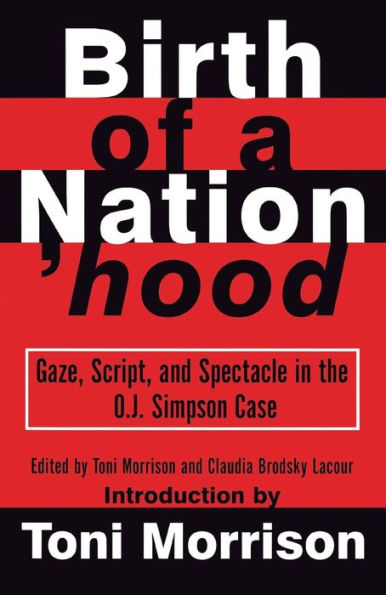Birth of a Nation'hood: Gaze, Script and Spectacle in the O.J. Simpson Case
Co-edited and introduced by Toni Morrison, winner of the Nobel Prize in Literature, Birth of a Nation'hood elucidates as never before the grim miasma of the O.J. Simpson case, which has elicited gargantuan fascination.
As they pertain to the scandal, the issues of race, sex, violence, money, and the media are refracted through twelve powerful essays that have been written especially for this book by distinguished intellectuals—black and white, male and female. Together these keen analyses of a defining American moment cast a chilling gaze on the script and spectacle of the insidious tensions that rend our society, even as they ponder the proper historical, cultural, political, legal, psychological, and linguistic ramifications of the affair.
With contributions by:
Toni Morrison, George Lipsitz, A. Leon Higginbotham, Jr., with Aderson Bellegarde Francois and Linda Y. Yueh, Nikol G. Alexander and Drucilla Cornell, Kimberlé Williams Crenshaw, Ishmael Reed, Leola Johnson and David Roediger, Andrew Ross, Patricia J. Williams, Ann duCille, Armond White, Claudia Brodsky Lacour
1119957697
As they pertain to the scandal, the issues of race, sex, violence, money, and the media are refracted through twelve powerful essays that have been written especially for this book by distinguished intellectuals—black and white, male and female. Together these keen analyses of a defining American moment cast a chilling gaze on the script and spectacle of the insidious tensions that rend our society, even as they ponder the proper historical, cultural, political, legal, psychological, and linguistic ramifications of the affair.
With contributions by:
Toni Morrison, George Lipsitz, A. Leon Higginbotham, Jr., with Aderson Bellegarde Francois and Linda Y. Yueh, Nikol G. Alexander and Drucilla Cornell, Kimberlé Williams Crenshaw, Ishmael Reed, Leola Johnson and David Roediger, Andrew Ross, Patricia J. Williams, Ann duCille, Armond White, Claudia Brodsky Lacour
Birth of a Nation'hood: Gaze, Script and Spectacle in the O.J. Simpson Case
Co-edited and introduced by Toni Morrison, winner of the Nobel Prize in Literature, Birth of a Nation'hood elucidates as never before the grim miasma of the O.J. Simpson case, which has elicited gargantuan fascination.
As they pertain to the scandal, the issues of race, sex, violence, money, and the media are refracted through twelve powerful essays that have been written especially for this book by distinguished intellectuals—black and white, male and female. Together these keen analyses of a defining American moment cast a chilling gaze on the script and spectacle of the insidious tensions that rend our society, even as they ponder the proper historical, cultural, political, legal, psychological, and linguistic ramifications of the affair.
With contributions by:
Toni Morrison, George Lipsitz, A. Leon Higginbotham, Jr., with Aderson Bellegarde Francois and Linda Y. Yueh, Nikol G. Alexander and Drucilla Cornell, Kimberlé Williams Crenshaw, Ishmael Reed, Leola Johnson and David Roediger, Andrew Ross, Patricia J. Williams, Ann duCille, Armond White, Claudia Brodsky Lacour
As they pertain to the scandal, the issues of race, sex, violence, money, and the media are refracted through twelve powerful essays that have been written especially for this book by distinguished intellectuals—black and white, male and female. Together these keen analyses of a defining American moment cast a chilling gaze on the script and spectacle of the insidious tensions that rend our society, even as they ponder the proper historical, cultural, political, legal, psychological, and linguistic ramifications of the affair.
With contributions by:
Toni Morrison, George Lipsitz, A. Leon Higginbotham, Jr., with Aderson Bellegarde Francois and Linda Y. Yueh, Nikol G. Alexander and Drucilla Cornell, Kimberlé Williams Crenshaw, Ishmael Reed, Leola Johnson and David Roediger, Andrew Ross, Patricia J. Williams, Ann duCille, Armond White, Claudia Brodsky Lacour
19.0
In Stock
5
1

Birth of a Nation'hood: Gaze, Script and Spectacle in the O.J. Simpson Case
448
Birth of a Nation'hood: Gaze, Script and Spectacle in the O.J. Simpson Case
448
19.0
In Stock

Product Details
| ISBN-13: | 9780679758938 |
|---|---|
| Publisher: | Knopf Doubleday Publishing Group |
| Publication date: | 02/04/1997 |
| Pages: | 448 |
| Sales rank: | 710,807 |
| Product dimensions: | 5.25(w) x 8.00(h) x 0.95(d) |
About the Author

From the B&N Reads Blog
